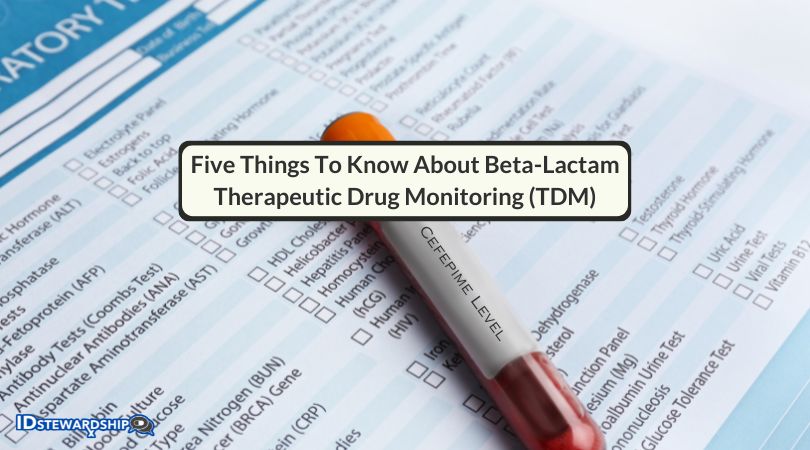In this article 4 clinical pharmacists provide insights, pulling from their advanced experience with beta-lactam therapeutic drug monitoring (TDM).


Authored By: Kathryn DeSear, PharmD, BCIDP, AAHIVP, FIDSA; Barbara Santevecchi, PharmD, BCPS, BCIDP; Veena Venugopalan, PharmD, BCIDP; Lisa Vuong, PharmD
Article Posted 28 November 2023
Beta-lactam antibiotics are time-dependent antibiotics, which means that by increasing the time the free drug concentration remains above the minimum inhibitory concentration (%fT>MIC) of the pathogen at the site of infection, bactericidal activity will be maximized.1 For this reason, use of extended infusion over 3 to 4 hours or continuous infusion strategies can be ideal.
Historically, therapeutic drug monitoring (TDM) has been widely utilized for vancomycin and aminoglycosides given the narrow therapeutic index. Conversely, TDM has not been performed for beta-lactams because they were generally thought to be safe and well tolerated due to a wide therapeutic window. Furthermore, lack of availability of assays has limited the use of beta-lactam-TDM in clinical practice in the United States as well as in most parts of the world.
Beta-lactams such as piperacillin-tazobactam, cefepime, and meropenem form the backbone of antibiotic regimens in the sickest, most vulnerable hospitalized patients. This reinforces the need to focus efforts on optimizing beta-lactam dosing because suboptimal serum concentrations may impact therapeutic outcomes and result in the amplification of resistant bacteria.2
Beta-lactam-TDM enables individualized antibiotic dosing, thereby challenging the “one size fits all” approach of standard dosing regimens. Beta-lactam-TDM is particularly useful in critical illness because pharmacokinetic (PK) variability increases the risk of over or under exposure of beta-lactams.3 PK refers to the movement of drug through the body over time as influenced by the processes of absorption, distribution, metabolism, and excretion (i.e., “how the body affects the drug”).
In this article we will highlight five things to know about beta-lactam therapeutic drug monitoring by discussing key questions on each point. We will use a case to emphasize some points. Let us begin!
PATIENT CASE
An elderly, frail nursing home resident presents to the emergency department (ED) with a three-day history of shortness of breath, altered mental status, and night sweats. In the ED, she is febrile and subsequently received several fluid boluses and was started on vasopressors for blood pressure support. A chest CT shows multilobar pneumonia.
Weight: 35kg
Estimated creatinine clearance: 75 ml/min.
Serum creatinine on admission: 0.42 mg/dL
Question 1: Why perform beta-lactam TDM?
A systematic review revealed a 30-day mortality rate of 35% from septic shock and 24% from sepsis.4 Given the negative clinical outcomes related to these illnesses and the high PK variability among critically ill patients, an individualized dosing approach with TDM should be considered.5
The updated surviving sepsis guidelines recommend optimizing the dosing of antimicrobials based on accepted pharmacokinetic/pharmacodynamic (PK/PD) principles and specific drug properties.6 PD is the study of effect (efficacy and toxicity) once the drug has reached a specified site of action (i.e., “how the drug affects the body”).
A study of unbound beta-lactam concentrations in an ICU revealed that 33% and 63% of doses needed to be increased to attain PK/PD targets of 100%fT > MIC and 100%fT > 4xMIC, respectively.7 An evaluation of beta-lactam-TDM practices from the University of Florida Health hospital revealed that 1 of every 4 beta-lactam doses required modification following beta-lactam-TDM.8
Beta-lactam TDM has the potential to impact clinical outcomes by optimizing PK/PD.
Question 2: Which patients should have beta-lactam TDM performed?
Institutions considering implementation of a beta-lactam-TDM program should focus initial efforts on patients who are expected to have derangements in PK/PD. Patient characteristics that may be associated with alterations in beta-lactam PK/PD include critical illness, extremes of age or weight, organ dysfunction (e.g., renal impairment or augmented renal clearance), and hypermetabolic disease states such as cystic fibrosis (see Figure 1). These factors increase the potential for over or under exposure of beta-lactams, which may in turn predispose patients to toxicities or a suboptimal response to therapy.
Critically ill patients make up a unique population with several elements that may alter beta-lactam exposure, some of which include hypoalbuminemia (associated with an increase in unbound drug for highly protein bound drugs, such as ertapenem or ceftriaxone, along with potential for increased renal clearance), increased volume of distribution (Vd) for beta-lactams which are hydrophilic drugs, and requirement for organ support (e.g., continuous renal replacement therapy, extracorporeal membrane oxygenation, and molecular adsorbent recirculating system).8,9
Pathogen level characteristics that support beta-lactam TDM include organisms with minimum inhibitory concentrations (MIC) at or above the susceptibility breakpoint, multidrug resistant organisms with few alternative treatment options, and severe or deep-seated infections, such as CNS infections. 8,10 In addition, patients who require several weeks or more of beta-lactam therapy may benefit from TDM for dose optimization and to limit risk of toxicities and resultant alterations in therapy.
Beta-lactam TDM may be the missing piece certain special populations need to have a positive clinical outcome.
PATIENT CASE CONTINUED I
The patient described in the case above has several factors that produce PK/PD variability and support beta-lactam TDM; these include advanced age, critical illness, and low body weight.

Figure 1: Factors producing PK/PD variability
(MIC: Minimum inhibitory concentration; ARC: Augmented renal clearance; RRT: Renal replacement therapy; ECMO: Extracorporeal membrane oxygenation)
Question 3: When should beta-lactam concentrations be ordered?
TDM is generally defined as the clinical laboratory measurement of a chemical parameter that, with appropriate medical interpretation, will impact drug dosing.11 TDM also refers to the individualization of drug dosage by maintaining plasma or blood drug concentrations within a targeted therapeutic range or window at the site of infection.11
Many clinicians have adopted model-informed precision dosing (MIPD) for monitoring of vancomycin. Dosing software which incorporate Bayesian forecasting, predicts an optimal initial dose using population PK models (PK data used to recommend a dose to achieve a predefined PK/PD target) and data from an individual patient (covariates).12-13 When measured drug concentrations become available, these data together with existing population PK data can be used to derive patient specific PK using Bayesian estimation to individualize dosing regimens.13
MIPD for beta-lactams is far less commonly used when compared to vancomycin. A more simplistic approach with a linear regression model can be utilized to estimate patient-specific PK parameters. Sampling of the antimicrobials is traditionally performed at the end of each dosing interval to obtain a trough or Cmin (concentration at the end of the dosing interval). Cmin provides information about the drug concentration at one snapshot in time. However, to accurately ascertain the clearance or volume of distribution (other key PK data points), additional samples earlier in the dosing interval are required.
In a one-compartment model, the patient’s PK parameters are calculated from at least two measured serum concentrations. This is depicted in Figure 2. These PK parameters are then inserted into first order kinetic equations to estimate exposure with various dosing regimens.

Figure 2. First-order kinetics to estimate patient-specific PK
Question 4: How are beta-lactam concentrations interpreted and what is the process for dose adjustment?
We will continue the patient case here to discuss this.
Vancomycin and cefepime 2 grams every 8 hours were started soon after blood cultures were collected. A cefepime peak and trough were collected, as shown here:

Similar to vancomycin, beta-lactam concentrations are interpreted under the context of a patient’s renal function and timing of the concentrations drawn relative to when the dose was given. Given the clinical status of the patient and as there are no positive cultures at this time, it is reasonable to use the Clinical and Laboratory Standards Institute (CLSI) susceptibility breakpoint for cefepime vs. Pseudomonas aeruginosa as a surrogate for MIC target (i.e., 8 mcg/mL).
| Sample | Total concentration (mcg/mL) | Estimated free concentration (mcg/mL) = total concentration x 80% |
| Peak, C1 | 181.8 | 145.4 |
| Trough, C2 | 63.4 | 50.7 |
The free concentration is estimated from the total concentration based on published estimates for protein binding. Estimating unbound drug is an essential step if the lab performing the assay only performs total concentrations since it is the unbound (free) drug that is able to exert its antibacterial effects (Figure 3). For cefepime, estimated protein binding is ~20%.14 A visual representation of bound versus unbound beta-lactam drug is shown in Figure 3.

Figure 3. Unbound vs. bound beta-lactam
For our patient we will assume that drug elimination follows first-order kinetics (see Figure 2). The elimination rate constant (ke) and half-life (t1/2) can be calculated using the following equations:

and assess the half-life. Typically, half-life for cefepime is about 2-3 hours. Therefore, given prolonged half-life, extending the dosing interval may be considered.
and assess PK/PD target attainment. Currently fCmin is ~5.8 times above the MIC target of 8 mcg/mL for the pathogen (e.g., empiric coverage vs. P. aeruginosa).
A PK/PD target of 100%fT>1-4x above MIC is recommended at our institution for deep seated infections, critically ill patients, and minimizing the selection of resistance.14,15,16 The data around optimal PK/PD targets continue to evolve. There are several excellent anti-infective dosing consensus papers and review articles which discuss this topic in greater detail.14,15,17,18 The current PK/PD target exceeds the desired range and further justifies extending the dosing interval.
DOSING ADJUSTMENT BASED ON BETA-LACTAM-TDM: Switch to cefepime 2 grams every 12 hours
Question 5: Which laboratories perform beta-lactam concentration analysis?
There are a number of labs that perform beta-lactam level analysis. Table 1 provides a list, which is not all-inclusive.

Table 1. Labs performing beta-lactam-TDM9
(RUO: Research use only; LC MS MS: Liquid chromatography-mass spectrometry)
Closing Comments
Beta-lactam TDM offers an opportunity to individualize dosing to the patient and pathogen, with the goals of optimizing therapy and minimizing toxicities. A recent meta-analysis showed that TDM-guided beta-lactam dosing in critically ill patients was associated with improved PK/PD target attainment, clinical cure, and microbiological cure.10 No associations were identified with regard to mortality and length of stay.
Beta-lactam TDM may be best viewed as a tool to individualize dosing and further alter the dogma of one size fits all dosing of beta-lactams.
References
- Turnidge JD. The pharmacodynamics of beta-lactams. Clin Infect Dis. 1998;27(1):10-22.
- Barreto EF, Webb AJ, Pais GM et al. Setting the beta-lactam therapeutic range for critically ill patients: Is there a floor or even a ceiling? Crit Care Explor. 2021;396):e0446.
- Martinez MN, Papich MG, Drusano GL. Dosing regimen matters: the importance of early intervention and rapid attainment of the pharmacokinetic/pharmacodynamic target. Antimicrob Agents Chemother. 2012;56(6):2795-805.
- Bauer M, Gerlach H, Vogelmann T et al. Mortality in sepsis and septic shock in Europe, North America and Australia between 2009 and 2019- results from a systematic review and meta-analysis. Crit Care. 2020;24(1):239.
- Legg A, Carmichael S, Chai MG, Roberts JA, Cotta MO. Beta-Lactam Dose Optimisation in the Intensive Care Unit: Targets, Therapeutic Drug Monitoring and Toxicity. Antibiotics (Basel). 2023;12(5):870.
- Evans L, Rhodes A, Alhazzani W et al. Surviving sepsis campaign: international guidelines for management of sepsis and septic shock 2021. Intensive Care Med. 2021;47(11):1181-1247.
- Wong G, Briscoe S, McWhinney B, Ally M, Ungerer J, Lipman J, Roberts JA. Therapeutic drug monitoring of β-lactam antibiotics in the critically ill: direct measurement of unbound drug concentrations to achieve appropriate drug exposures. J Antimicrob Chemother. 2018;73(11):3087-3094.
- Venugopalan V, Hamza M, Santevecchi B, DeSear K, Cherabuddi K, Peloquin CA, Alshaer MH. Implementation of a β-lactam therapeutic drug monitoring program: Experience from a large academic medical center. Am J Health Syst Pharm. 2022;79(18):1586-1591.
- Fratoni AJ, Nicolau DP, Kuti JL. A guide to therapeutic drug monitoring of β-lactam antibiotics. Pharmacotherapy. 2021;41:220-33.
- Pai Mangalore R, Ashok A, Lee SJ et al. Beta-Lactam Antibiotic Therapeutic Drug Monitoring in Critically Ill Patients: A Systematic Review and Meta-Analysis. Clin Infect Dis. 2022;75(10):1848-1860.
- Kang JS, Lee MH. Overview of therapeutic drug monitoring. Korean J Intern Med. 2009;24(1):1-10.
- Wicha SG, Märtson AG, Nielsen EI et al. From Therapeutic Drug Monitoring to Model-Informed Precision Dosing for Antibiotics. Clin Pharmacol Ther. 2021;109(4):928-941.
- Novy E, Martinière H, Roger C. The Current Status and Future Perspectives of Beta-Lactam Therapeutic Drug Monitoring in Critically Ill Patients. Antibiotics (Basel). 2023;12(4):681.
- Guilhaumou R, Benaboud S, Bennis Y et al. Optimization of the treatment with beta-lactam antibiotics in critically ill patients-guidelines from the French Society of Pharmacology and Therapeutics (Société Française de Pharmacologie et Thérapeutique-SFPT) and the French Society of Anaesthesia and Intensive Care Medicine (Société Française d’Anesthésie et Réanimation-SFAR). Crit Care 2019;23(1):104.
- Abdul-Aziz MH, Alffenaar JC, Bassetti M et al. Antimicrobial therapeutic drug monitoring in critically ill adult patients: a Position Paper. Intensive Care Med. 2020;46(6):1127-1153.
- Sumi CD, Heffernan AJ, Lipman J, et al. What antibiotic exposures are required to suppress the emergence of resistance for gram-negative bacteria? A systematic review. Clin Pharmacokinet. 2019;58(11):1407-1443.
- Berry AV, Kuti JL. Pharmacodynamic Thresholds for Beta-Lactam Antibiotics: A Story of Mouse Versus Man. Front Pharmacol. 2022;13:833189.
- Onufrak NJ, Forrest A, and Gonzalez D. Pharmacokinetic and Pharmacodynamic Principles of AntiInfective Dosing. Clin Ther. 2016; 38 (9): 1930-1947
ABOUT THE AUTHORS
Kathryn DeSear, PharmD, BCIDP, AAHIVP, FIDSA
 Kate DeSear, PharmD, BCIDP, AAHIVP, FIDSA is a clinical specialist in infectious diseases at University of Florida (UF) Health Shands Hospital, an 1,162 bed academic medical center, and co-leads the antimicrobial stewardship program with the program’s physician director. She serves as the residency program director of the Infectious Diseases PGY-2 residency. She is also a clinical assistant professor at the UF College of Pharmacy (COP).
Kate DeSear, PharmD, BCIDP, AAHIVP, FIDSA is a clinical specialist in infectious diseases at University of Florida (UF) Health Shands Hospital, an 1,162 bed academic medical center, and co-leads the antimicrobial stewardship program with the program’s physician director. She serves as the residency program director of the Infectious Diseases PGY-2 residency. She is also a clinical assistant professor at the UF College of Pharmacy (COP).
She received her Doctor of Pharmacy from UF COP. She completed her pharmacy practice residency at Bay Pines Veterans Affairs Hospital and a specialty residency in infectious diseases at the UF Shands Hospital. Her areas of interest include antimicrobial stewardship, novel stewardship measures relating antimicrobial use to clinical or process outcomes, and rapid diagnostics.
Barbara Santevecchi, PharmD, BCPS, BCIDP
 Barbara Santevecchi, PharmD, BCPS, BCIDP is a Clinical Assistant Professor at the UF COP and practices as an Infectious Diseases Clinical Pharmacy Specialist at the UF Health Shands Hospital.
Barbara Santevecchi, PharmD, BCPS, BCIDP is a Clinical Assistant Professor at the UF COP and practices as an Infectious Diseases Clinical Pharmacy Specialist at the UF Health Shands Hospital.
She received her Doctor of Pharmacy from Wingate University and completed pharmacy practice and infectious diseases specialty residency training at the Medical University of South Carolina in Charleston, SC. Her interest areas include antimicrobial resistance, HIV, antimicrobial and diagnostic stewardship, and therapeutic drug monitoring.
Veena Venugopalan, PharmD

Veena Venugopalan, PharmD, BCIDP received her Doctor of Pharmacy degree from the University of Kentucky, College of Pharmacy and thereafter completed an Infectious Diseases residency at the University of Kentucky Medical Center.
She is currently a Clinical Associate Professor at the UF COP and serves as one of the Infectious Diseases clinical specialists at the UF Health Shands Hospital. In addition to her research and clinical interest in antimicrobial resistance, beta-lactam TDM, and antimicrobial stewardship, she is also passionate about global health.
Lisa Vuong, PharmD
 Lisa Vuong, PharmD is a clinical specialist in infectious diseases at UF Health Shands Hospital.
Lisa Vuong, PharmD is a clinical specialist in infectious diseases at UF Health Shands Hospital.
She received her Doctor of Pharmacy from the University of California, San Francisco. She completed her pharmacy practice residency and infectious diseases specialty residency at Henry Ford Hospital in Detroit, Michigan. Her areas of interest include implementation science, transitions of care, and antimicrobial stewardship.
RECOMMENDED TO YOU










Your point of view caught my eye and was very interesting. Thanks. I have a question for you.
Can you be more specific about the content of your article? After reading it, I still have some doubts. Hope you can help me. https://www.binance.com/fr/register?ref=GJY4VW8W